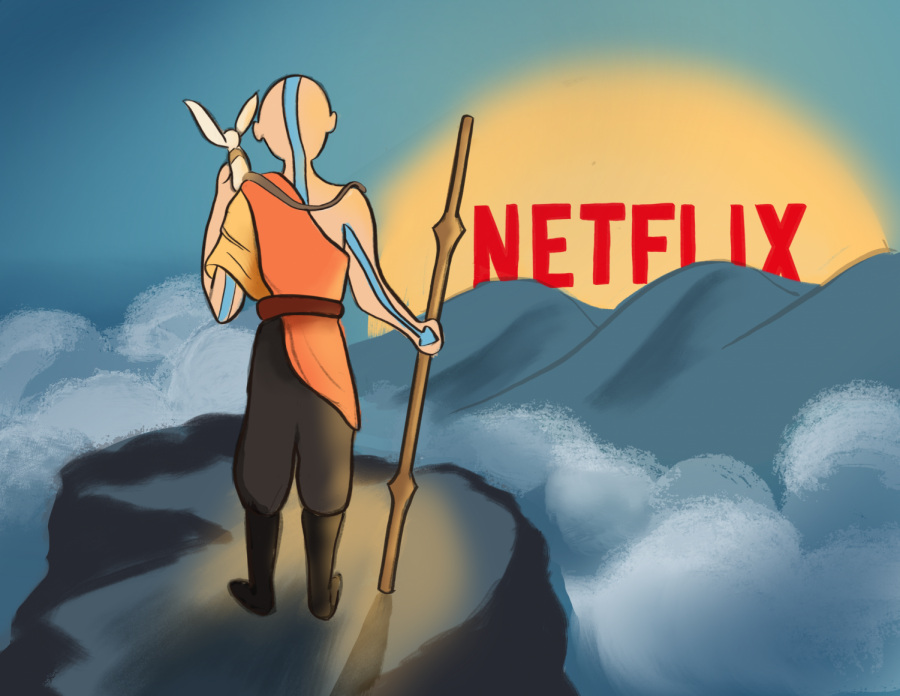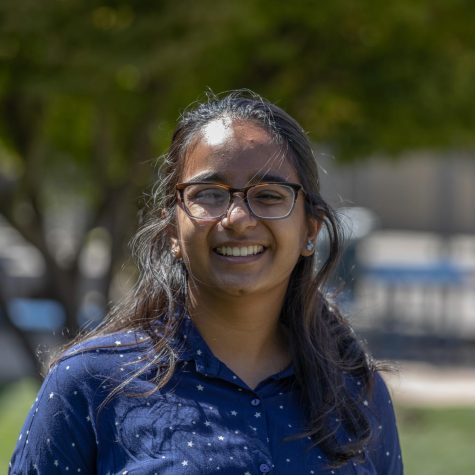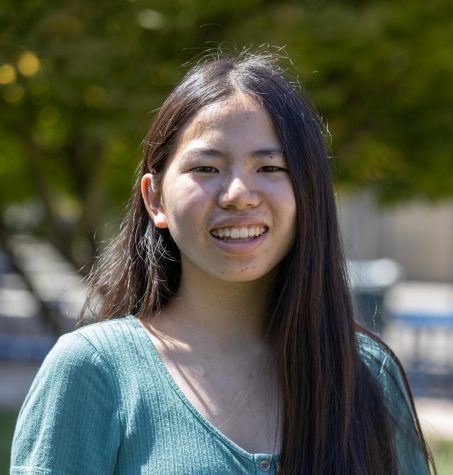‘Avatar’’s Netflix renaissance: The Gaang Returns
Aang looks out at the sky as Netflix rises in the east.
The internal strife of a fandom centers around many things: the ships, the worldbuilding, the theories, but most of all, the characters. Nowhere is there a better example of this than in the “Avatar: The Last Airbender” (“ATLA”) fandom, where there is a constant struggle to choose the most relatable character — an impossible feat. From the angsty, dishonorable teenager to the peppy, little Avatar himself; from the feminist mom-friend to the angry 12-year-old badass, “Avatar” delivers characters that anyone can love.
This year the debate has fired up again due to the return of “ATLA” to the Netflix world, which has spurred a renaissance of old and new fans alike, inspiring new content and discussions on our most beloved characters.
Olivia: Before it came out on Netflix, I was a content-starved fan jumping at any glimpse of “Avatar” on Instagram or the slightest hint that somebody else might be just as obsessed with it as I was. So when “Avatar” became available on Netflix, it was a welcome alternative to the pirated versions I depended on before. Even better, I could finally enlist my friends to watch it with me. Enter Kaavya.
Kaavya: I hadn’t seen “ATLA” until a couple months ago, when Olivia made me start watching with one of our other friends. And, of course, I fell completely in love with everything about it (mostly Zuko, but, you know).
Olivia: As for me, I still had a special spot in my heart for my childhood favorites, but rewatching “ATLA” made me appreciate some of its often-overlooked character development. After much discussion with Kaavya about our favorite characters, I discovered that Aang was mine. We all loved precious Aang as soon as he popped onto our screens with his classic opening line, “Will you go penguin sledding with me?” But Aang matures from a naïve, fun-loving little kid who avoids conflict to a more experienced Avatar who has learned how to confront his failures. As an Airbender, Aang is expected to emotionally detach himself, to think of himself as separate from the world around him. But throughout the series, Aang realizes his attachments to his friends make him stronger and give him something to fight for. Further, instead of thinking around his problems or approaching them from a different angle like Airbenders might, Aang learns that there is no one way to approach his obstacles and that he can face his problems head-on.
Kaavya: But even as he matured, Aang’s morals stayed true. He didn’t fight when he didn’t need to, and he never killed (if you exclude the poor buzzard wasp in the desert). Aang is a perfect example of the flat moral arc, something that I believe to be wholly underrated in TV. Characters don’t have to become cynical or immoral in order to grow. Although Aang occasionally dabbles in a hopeless outlook, he returns to what he is: an optimist through-and-through.
Olivia: While this was a fandom-wide renaissance, Sokka had the biggest popularity boost by far. Before this year, few appreciated Sokka as much as he deserved. No longer solely the comic relief, Sokka became the hero we all needed. He stepped up to become a leader, chugged respect-women juice (and cactus juice) and learned some much-needed humility, accepting his victories and his mistakes hand in hand.
Kaavya: Sokka has always been one of the smartest characters in the show, but as the series progresses, we see him become a true strategist, still intelligent but more self-assured. More than that, Sokka’s emergence as a fan-favorite has to do with how we see ourselves in him. Sokka is the only non-bender among a group of extraordinary super-people and because of that, he often feels inadequate. But his struggle to find purpose and who he is perfectly encapsulates how everyone can feel lost and powerless, whether it be us angsty teens or the entire quarantine-stricken population. Everyone can feel as though they are useless, but Sokka proves to us that everyone has their place. Sokka’s strengths — his creativity and versatility — make him as important and powerful as Toph or Katara. Sokka’s not nearly as appreciated as Katara or Aang, but without him, the “Gaang” wouldn’t have gotten very far.
Olivia: Getting back to flat arcs, we have to talk about Toph Beifong, a huge fan-favorite whose character development isn’t appreciated nearly enough. If you asked fans why they love Toph, they’d probably say Toph is just badass or really hilarious. But she’s also a great example of a young woman who’s solidly confident in herself and unabashedly lets other people know it. Still, behind that confident front, she can also be incredibly emotionally vulnerable when she’s surrounded by people who accept her for who she is.
Kaavya: At the beginning, Toph refuses to help or accept help from the Gaang, causing conflict between her and the others. She’s stubbornly independent because she’s determined to break free from a lifetime of being treated like a weak and helpless little girl by her parents. Ultimately, though, Toph learns that depending on others or asking for help doesn’t make her weaker. But of course, “ATLA”’s most iconic character arc comes from my favorite character, Prince Zuko of the Fire Nation.
Olivia: No Buzzfeed article about the best redemption arcs of all time will ever be complete without Zuko because his arc is the ultimate gold standard. Zuko transforms from the conflicted and misguided antihero into the righteous and lovable hero, determined to right his family’s wrongs. Along his long and arduous journey, Zuko not only has to face the intense turmoil inside himself but also the injustices of his own people. He finally gets his beloved honor back, but he also has to carry his nation’s legacy and try to repair the damage that his family has done.
Kaavya: There is a reason that we love Zuko and always will: He’s proof that even if you screw up, there is a way back. You, too, can ride an honor dragon into the sunset and learn how to make tea properly. People are capable of change. Despite the fact that he makes the most missteps of any character, Zuko’s sense of righteousness (and Uncle Iroh) always brings him back. Even when doing the right thing is difficult, Zuko never gives up on what he wants, regardless of what it is.
Olivia: Zuko’s episodes are usually the heaviest — where “ATLA”’s adult themes of imperialism, war and abuse are notably featured. From the very beginning, we see that Zuko is far from a black-and-white villain (cough cough, Ozai). He’s had to struggle and fight to get where he is, and his tragic backstory makes us root for him, no matter which side he started on. Zuko has unquestionable honor and strong morals that take him on a steady character arc up until his complete Uno Reverse in the season two finale. Although we all wanted peaceful Zuko, otherwise known as “Lee from the tea shop” to have a happy ending, his setback — betraying Aang and his uncle — is a necessary one. His triumphant return to the Fire Nation as a hero fully exposes his country’s flaws as well as his inner turmoil. Even when he has everything he wants as the beloved crown prince, Zuko realizes the Fire Nation’s illusion of greatness is deeply flawed. That is the most independent we ever see Zuko, where he has to face his struggles without Uncle Iroh’s advice (and tea) by his side. Zuko’s brief return to the dark side makes his electrifying confrontation with his father even more satisfying. One of the best moments in “ATLA”, hands down, is Zuko redirecting lightning at his father, finally rejecting his family’s legacy and forging his own path.
Kaavya: Despite the differences between these arcs, what each has in common is a rejection of past beliefs. Every character makes the verdict that just because people have done something before doesn’t mean they should do it now. From Katara rejecting and disproving sexist values at the North Pole to Aang refusing to believe that murder is the only way to end the war despite what the previous Avatars tell him, “ATLA” signifies how people have the power to decide their own futures. What makes the characters win is that they don’t repeat their ancestors’ mistakes. They make their own paths.
Olivia: Even though most of us don’t battle Fire Lords, we all see ourselves in these characters and their arcs because “ATLA” constantly reminds us that, though they have to save the world, they are just kids. Aang is the most powerful bender alive, but he’s also a 12-year-old boy with a massive crush. Sokka is a skilled warrior and master strategist, but he’s incredibly awkward with his first girlfriend (granted, she does turn into the moon). Zuko is the honor-obsessed crown prince, but like the rest of us he survives on angst alone and zero sleep.
Kaavya: While “Avatar” may seem like just a cartoon from Nickelodeon, the characters make it so much more than that. It is the ultimate world-saving, coming-of-age TV show.
Olivia: So if it’s been a while since your last “ATLA” rewatch, there’s no time like the present to get that Netflix subscription for (only) $8.99 a month.
Kaavya: Netflix, please sponsor us (also please don’t Shyamalan the live action or we’ll relinquish our $8.99 monthly payment).
This article is not sponsored by Netflix or Netflix Party, we are sorry to say. We would prefer that it were, but it is not.





